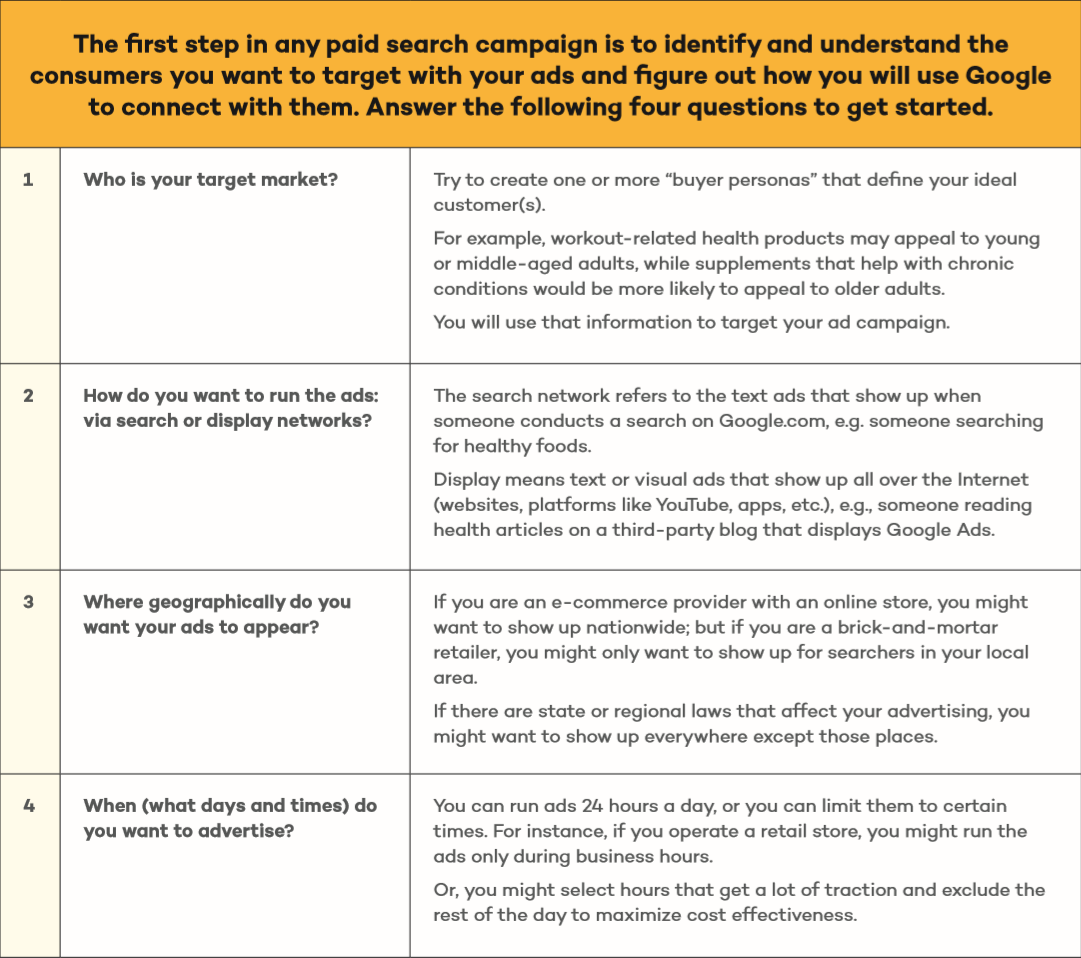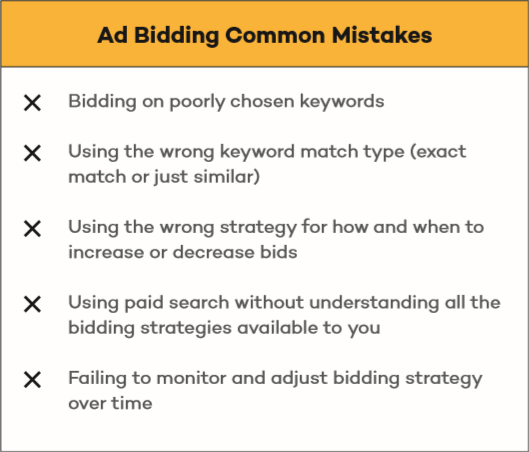SEO
Free SEO Analysis
SEO Services
Content Marketing Services
Local SEO
Link Building Services
Specialized SEO Services
PPC
REPUTATION MANAGEMENT
Free Reputation Management Analysis
Reputation Management Services
Review Management Services
Specialized Reputation Management Services
CEO Reputation Management
Brand Enhancement
Business and Directory Listings
Comprehensive Reputation Management Audit
SOCIAL MEDIA
Free Social Media Analysis
Specialized Social Services
WEB DEVELOPMENT
Free Website Analysis
Web Design Services
Mobile Development Services
Website Maintenance Services
Specialized Development Services
MARKETING AUTOMATION
Free Marketing Automation Analysis
Specialized Marketing Automation Services
Comprehensive Marketing Automation
INDUSTRIES
ABOUT DMA
WHITEPAPER
Nutraceuticals: How to Use Google Ads
Google Ads
1st September 2022
Executive Summary
For nutraceutical companies to succeed today, they must show up when consumers go online to find information about health and wellness
If used in conjunction with a search engine optimization program, paid search is an excellent way to generate traffic and sales for your site
Most people use the Home Page as the landing page, but that’s a big mistake! Instead, create a dedicated page for the ad or ad group.

How can nutraceutical producers ensure they are primed and positioned to acquire the maximum number of customers online?
Americans are eager to live longer, healthier lives, and they’re willing to pay generously to make it happen. Nearly two in three American adults take some form of nutritional supplement to bolster their heath.[i] That consumption is fueling tremendous market growth, with the U.S. market for dietary supplements projected to reach as high as $57 billion by 2024. That will continue to attract more health product and food producers into this market, making it more competitive than ever.[ii]
But for nutraceutical companies – those who produce consumables that contain ingredients or additives with medicinal wellness benefits – to succeed today, they must show up when consumers go online to find information about health and wellness. Paid search – also known as search advertising and pay-per-click (PPC) advertising – accomplishes that.
With paid search via Google, you can claim a position on the first page of search results, if you use the right bid strategy. In other words, these ads offer guaranteed placement above the organic search results, which is incredibly valuable real estate, given that the top 3 paid search ads get half (46%) of the clicks on the page. You might think that users would skip down, but 46% of Internet users can’t tell the difference between PPC ads and organic search results.[iii]
Given that supplement users spend as much time surfing the Internet as they do watching TV (4 hours daily) [iv] and that half of them turn to the Internet as their first source when researching health-related topics, organizations can thus use search ads to reach potential customers when and where they’re seeking information.[v]
Paid search works to increase traffic – especially traffic with buying intent – and sales. Google reports that businesses make an average of $2 in income for every $1 they spend in AdWords.[vi] After all, nearly two thirds (64.6%) of people click on Google Ads when they are looking to buy an item online.[vii]
But how can you get started with paid search? This paper will guide you, step by step, through the six main steps of starting and running an effective paid search campaign.
We’ll focus on Google specifically due to its overwhelming market share: the search giant owns 74.28% of the search market.[viii] Thankfully, Google makes paid search straightforward. Let’s get started.
Google Ads makes search advertising a snap, but you must make smart decisions at every step if you are going to be successful.
1: Target Your Audience

2: Select Keywords
Getting the keywords right may be your most important task. Success depends on reaching the right customers; that means using the same keywords your target audience will in fact use to search for information.
Start by generate a list of keywords for every product or resource that you offer. Then, do some keyword research to understand whether people actually search for those terms. Remember also to capture “buying intent” in your keywords if you’re hoping for an online sale: words like “buy”, “sale”, “coupon”, “deal”. Similarly, if you want to capture users during the research phase of the shopping process, use words like “review”, “best”, “how to”, “comparison”, “ways to”, “I need to”.
In some cases, it might also be a good idea to include location; this is help you target locally. Focusing on local searches will often reduce costs but also narrows the scope of your audience.
3: Create Ads
The next step is creating the actual ads your prospective customers will see. Mostly importantly, the copy must be compelling enough to catalyze clicks. If the ad doesn’t give customers reason to click, it’s a waste of space.
For nutraceuticals, this often means describing the health benefits. Research from the Institute of Food Technologists has found that shoppers tend to seek several claims in tandem when evaluating supplements and nutraceuticals, so don’t be shy about describing the benefits.[ix] That said, always make sure your ads comply with applicable laws (see the table below).
Assuming your ads satisfy those requirements, just make sure they incorporate key differentiators, benefits, and unique features. Ideally, you should also use your target keyword in the ad title. Note that you can run multiple ads, and you should always test multiple versions to see what works best.

4: Set Up Landing Pages
Once the ads are written, where will they take people who click on them? Answer: the landing page, which is where customers “land” after clicking on your ad. These pages do the actual sales work of your website.
Most people use the Home Page as the landing page, but that’s a big mistake! Instead, create a dedicated page for the ad or ad group. A good landing page will be tailored so that it meets the customer’s expectations. Whatever information the customer expects or wants to see after clicking on the ad should be presented to them immediately and clearly. When they land on the Home Page, they must often go searching if they want to find that information, and just as often they’ll just bounce off your website instead. Give them what they want right away.
Note that Google itself will evaluate your landing pages, and it recently updated its own “Abuse of the Ad Network” policy to prohibit “ads promoting sites that offer little unique value to users and are focused primarily on traffic generation.”[x] In other words, your website itself needs to offer valuable and user-friendly content, or you may run into problems with Google.

5: Bid on Ad Position
Here’s where paid search gets interesting. Unlike some other forms of advertising, where companies pay a flat fee for their ads to appear, Google Ads operates like an auction house. Advertisers bid on the position they want (how high on the page they want their ad to appear) for a given keyword. They agree to pay a certain amount for every click on the ad. If you bid more than your competitor, your ad gets placed above theirs. After all, the highest placement is the most visible and, thus, the most valuable.
That said, there’s a lot of strategy that goes into the bidding process. You can manually control individual bids, or you can set up automatic bidding rules where you change how much you’re willing to bid according to geography, schedule, or even device used (mobile or desktop). For example, you could increase your bid price at certain times when you want to highlight a promotion.
You can also tell Google what kind of strategy to use when setting bids: maximize the number of clicks, bid to always show up on the first page, target a specific cost per acquisition, etc.

Conclusion
Particularly if used in conjunction with a search engine optimization program, paid search is an excellent way to generate traffic and sales for your site. SEO can take time to start working and is often something of a moving target; paid search works instantly and continuously (as long as you have the budget for it). The two complement each other perfectly, with paid search giving advertisers the power to reach their most desired online audience immediately.
This is vital in a world in which nine out of ten consumers turn to the Internet to resolve health queries and concerns.[xi] Reaching consumers where and when they look online for relevant health-related inquiries is key for nutraceutical companies, and Google Ads is the perfect medium through which to expand market share, increase customer base, and generate new sales.
[i] https://www.kantarmedia.com/us/thinking-and-resources/blog/advertising-to-reach-vitamin-and-dietary-supplement-users
[ii] https://www.statista.com/statistics/828481/total-dietary-supplements-market-size-in-the-us/
[iii] https://www.ppcresellers.com/blog/9-pay-per-click-ppc-statistics-2016/
[iv] https://www.kantarmedia.com/us/thinking-and-resources/blog/advertising-to-reach-vitamin-and-dietary-supplement-users
[v] https://www.kantarmedia.com/us/thinking-and-resources/blog/advertising-to-reach-vitamin-and-dietary-supplement-users
[vi] https://economicimpact.google.com/about/#/?sections_activeEl=introduction
[vii] https://www.wordstream.com/blog/ws/2012/07/17/google-advertising
[viii] https://netmarketshare.com/search-engine-market-share.aspx
[ix] http://www.ift.org/food-technology/past-issues/2015/april/features/the-top-ten-food-trends.aspx?page=viewall
[x] https://support.google.com/adwordspolicy/answer/6020954
[xi]https://www.thinkwithgoogle.com/intl/en-aunz/marketing-resources/micro-moments/micro-moments-guide-how-australians-find-and-choose-health-services/
Our Sales team